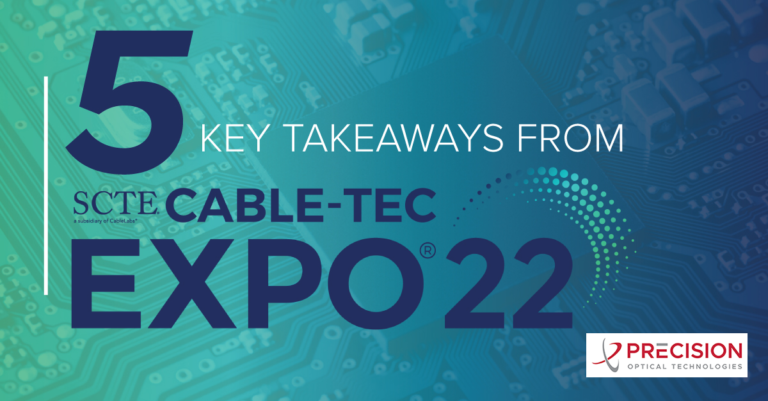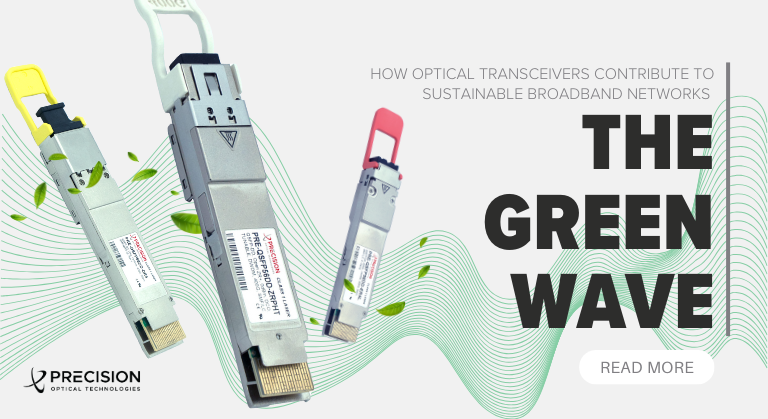
5 Key Takeaways from the SCTE Cable-Tec Expo

Precision OT enjoyed connecting in person this year at the SCTE Expo and came away with some fresh insights on where cable network technology is heading:
1) FDX vs FDD
While a clear winner has not yet been declared, the technology battle between Full Duplex DOCSIS (FDX) and Frequency Division Duplexing (FDD, or sometimes called Extended Spectrum DOCSIS) persists. Yes DOCSIS 4.0 is coming, but it’s
clear there’s still a lot of creativity happening with 3.1 HFC plants to achieve 4.0 performance. Looking at it holistically, we lean towards Extended Spectrum edging it out due to lower costs, especially for those operators who are nowhere near the “node + 0” approach needed for FDX.
2) PON and Fiber: No Longer “Taboo” Words for Cable Operators
As alluded to above, not everyone is ready to march straight down the DOCSIS 4.0 path. Many operators are open to multi-technology approaches not to just remain competitive–but to excel as market leaders. Some will squeeze as much out of 3.1 as they can. Some will use a hybrid, more targeted approach of DOCSIS 4.0 in some areas, DOCSIS 3.1 in others and then new fiber plants in highly competitive areas. Others will skip DOCSIS 4.0 altogether and go straight to all fiber. It seems nearly every cable company is now deploying XGS-PON to some extent. With its symmetrical rates of 10Gb/s, XGS-PON is an optimal solution for supporting businesses and multiple dwelling units (MDUs) in addition to residential services.
3) Maximizing 10G Networks and Reaching Beyond
CableLabs President and CEO Phil McKinney announced the winners of the first 10G Challenge which encouraged entrants to innovate around possibilities enabled by the emerging 10G network. Inherent in that challenge is ensuring the 4 tenets of faster internet speeds, better security, lower latency and improved reliability. Similarly, the buzz continues around last mile improvements and the need for greater-than-10G optical links. Handling and accounting for chromatic dispersion is key to extending distances. Technologies such as 400 ZR/ZR+ and 25G extended reach technologies are emerging to meet these challenges.
4) 400G ZR/ZR+: Going the Distance
There continues to be much interest in 400G ZR and discussion of how close it is to meeting the original goal of reducing the cost of Data Center Interconnects (DCIs). A lot of questions still remain about the capabilities of 400G ZR/ZR+, but it’s clear all the operators want to be at that 0 to +1 dBM transmit level. First-generation 400ZR and 400G ZR+ pluggable optics have been limited by low output power, specified as -10 or -11 dBm. Fortunately, 0 dBm 400G ZR+ QSFP-DD optics are starting to emerge and are expected to become more readily available in 2023.
5) Tunables, Tunables, Tunables
Throughout the Expo, it was pretty clear to us that everyone is interested in DWDM tunable technology. In areas where fiber is expensive or sparse, a MUX/DEMUX with tunables can be used to increase or better utilize available fiber. Tunables are driving DWDM due to offering increased flexibility, ease of use, faster deployments and less sparing – all resulting in reduced OPEX. 10G and 25G tunables are very popular now and going forward we’ll see this technology emerge in 400G ZR as well. Tunables are heavily utilized in a wide variety of applications including Transport, Core, Metro, IP, Access Reach and Remote PHY.







